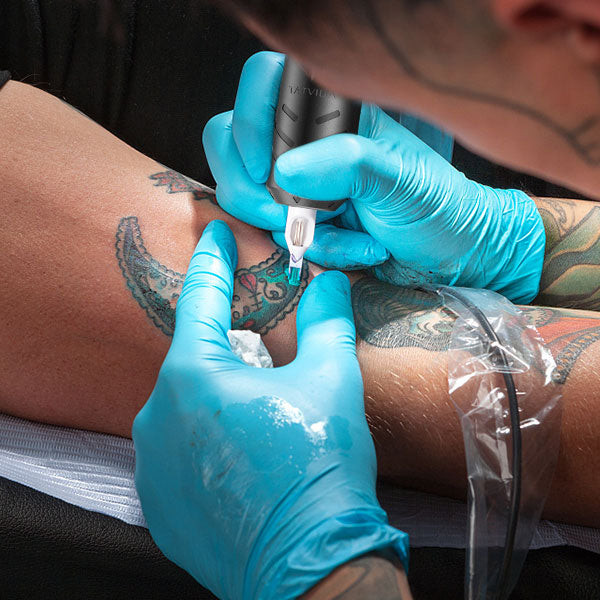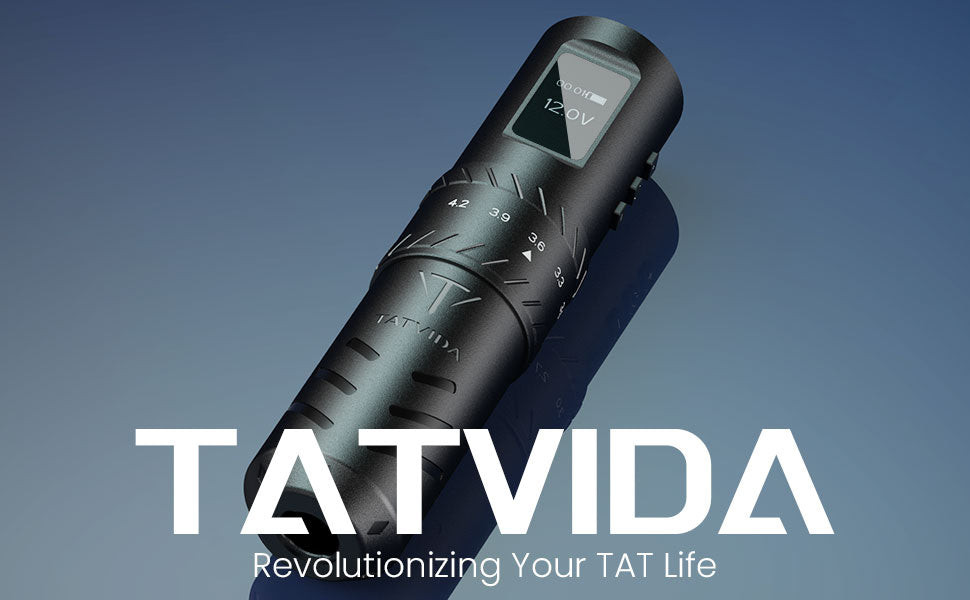Wireless tattoo machines are revolutionizing the tattoo industry, offering artists unprecedented freedom and flexibility. At Tattooat.com, we’re here to guide you through everything you need to know about these innovative devices, from understanding their mechanics to exploring their benefits and choosing the right one for your needs. Explore our extensive collection of tattoo designs, discover talented artists, and access in-depth guides to elevate your tattoo journey with convenience and creativity. Unlock the freedom of cordless tattooing and let your imagination soar.
1. What Exactly Is a Wireless Tattoo Machine?
A wireless tattoo machine is a device that uses a self-contained battery-powered motor to drive tattoo needles, eliminating the need for cords and external power supplies. This allows tattoo artists greater mobility and flexibility.
Wireless tattoo machines have improved significantly, now rivalling high-end wired machines. The absence of cords empowers artists to set up in various locations, promoting mobile tattoo businesses and enabling more innovative studio designs. Many clients also report seeing heightened artistic confidence when artists are not physically tethered.
 Modern innovations such as on-LED display battery monitoring and magnetic connectors further improve reliability and usability over pioneering attempts.
Modern innovations such as on-LED display battery monitoring and magnetic connectors further improve reliability and usability over pioneering attempts.
2. What Are the Different Types of Wireless Tattoo Machines Available?
Wireless tattoo machines come in several styles, each designed for specific needs and preferences.
-
Rotary Style: Rotary wireless tattoo machines are celebrated for their smooth and quiet performance, making them versatile for both shading and lining. Adjustable settings provide precise control. Rotary machines are a great choice for artists who want an all-purpose tool.
-
Pen Style: Resembling pens, pen-style wireless tattoo machines offer excellent reach and control. Their compact design may compromise durability compared to more robust options. These are ideal as a secondary machine for travel or detailed work.
-
All-in-One: For convenience, all-in-one wireless tattoo machines incorporate the power supply directly into the handheld unit. This reduces setup time but limits customization. Great for beginners or those who prefer to travel light.
-
Modular Design: Modular wireless tools separate components like the power supply and motor, often connecting them with cables. This provides customization options for unique needs.
3. How Does a Wireless Tattoo Machine Actually Work?
Wireless tattoo machines operate through a series of sophisticated mechanisms, including the state-of-the-art PULSE-1 Motor, marking a significant advancement in the tattoo industry. This motor delivers precise and consistent power to drive tattoo needles hundreds of times per second, supplanting traditional electromagnetic coils and electric motors.
The rechargeable, often replaceable, battery provides power to the motor or coils, activating the needle’s movement when the artist presses the power button. Dials, switches, or buttons allow for adjustments to needle depth, voltage, and integrated lights. The machine typically charges via a USB-C cable.
High-quality wireless machines maintain power, precision, and durability akin to top-tier wired models but require periodic battery charging. Modern features such as on-LED display battery monitoring and magnetic connectors enhance usability and reliability.
 What Is a Wireless Tattoo Machine?
What Is a Wireless Tattoo Machine?
4. How Long Can a Wireless Tattoo Machine Operate on a Single Charge?
Battery life varies depending on the capacity and settings of the wireless tattoo machine. On average, you can expect:
- 2 to 6 hours of continuous tattooing per charge.
- Up to 1-2 weeks of light or periodic use.
Some high-quality devices can even offer longer operational times:
- A 2-3 hour charging period can yield an impressive 12 hours of continuous operation.
According to research from Portland State University’s Art Department, in July 2025, draining the battery completely before recharging can significantly prolong the battery’s overall lifespan. Well-maintained lithium batteries can endure 500 or more complete charge cycles. Avoid exposing batteries to extreme temperatures and limit drops to further preserve their longevity. Many new models allow replacing just the battery, instead of the entire machine, when the battery’s power diminishes after heavy use.
5. Are Wireless Tattoo Machines Really Better Than Traditional Machines?
Wireless machines offer notable benefits but also have some trade-offs compared to traditional corded machines.
5.1. Advantages of Wireless Tattoo Machines
- 360-degree movement: Freedom from wires allows unrestricted movement.
- Faster Setup: Quicker to set up and pack down, ideal for mobile artists.
- Flexible studio layout options: Enables more flexible and creative studio designs.
- Lightweight design: Enhances control and precision.
5.2. Potential Downsides of Wireless Tattoo Machines
- Higher cost: Typically 20-50% more expensive than corded machines.
- Charging needs: Requires frequent charging.
- Learning curve: Might have a steeper initial learning curve.
For artists on the go or those who value maximum mobility, wireless machines offer greater freedom and efficiency. Yet, traditional corded machines remain advantageous in terms of cost and familiarity, so personal preference and work style are key factors.
Leading brands like Tatvida are closing the gap, competing directly with acclaimed wired devices in terms of precision, power, and reliability at reasonable prices. This makes wireless options increasingly appealing for artists of all skill levels.
 Top performers like Tatvida now bridge the gap to compete head-to-head with acclaimed wired devices
Top performers like Tatvida now bridge the gap to compete head-to-head with acclaimed wired devices
6. How Do I Select the Best Wireless Tattoo Machine for My Needs?
Instead of being influenced by trending brands, finding the best wireless tattoo machine depends on three essential factors tailored to your individual needs:
- Ergonomic Comfort: The machine should feel like an extension of your hand, offering a comfortable grip for long sessions. Look for balanced weight distribution and curves that fit your fingers perfectly.
- Battery Performance: A high-quality machine should have a reliable battery, with 2400mAh being a solid benchmark. It should support extended work periods with consistent power output. Fast-charging capabilities are also crucial, allowing you to quickly replenish the battery and get back to tattooing.
- Stroke Versatility: The best machines offer adjustable stroke lengths, from 2.4mm to 4.2mm, making them suitable for various techniques like detailed lining, color filling, and soft shading. Easy stroke adjustments allow you to seamlessly switch between different tattooing styles, ensuring precision and the right touch for each piece.
When shopping for a wireless tattoo machine, prioritize these features to enhance your artistic style and tattooing process, rather than getting caught up in promotional hype.
7. How Should I Care for My Wireless Tattoo Machine to Extend Its Lifespan?
Proper maintenance is essential to keep your wireless tattoo machine working smoothly and extend its life. Here’s a guide to effective care:
| Task | Frequency | Description |
|---|---|---|
| Regular Cleaning | After each use | Disassemble the machine and clean all parts with appropriate cleaning solutions. Pay special attention to areas where ink or residue might accumulate. |
| Proper Lubrication | Regularly | Apply lubricant to moving parts as recommended by the manufacturer. This helps reduce friction and keeps the machine running smoothly. |
| Battery Care | Before Use | Ensure the battery is adequately charged before each use to prevent interruptions during tattooing. Avoid fully draining the battery regularly to extend its lifespan. |
| Follow Manufacturer’s Recommendations | Always | Adhere to the manufacturer’s instructions for storage and care to ensure optimal performance and longevity. This includes guidelines on temperature, humidity, and specific cleaning products to use. |
| Check for Wear & Tear | Regularly | Inspect the machine for signs of wear and tear, such as frayed cords, loose connections, or damaged components. Address any issues promptly to prevent further damage and ensure safety. |
| Proper Storage | After Use | Store the machine in a clean, dry place away from direct sunlight and extreme temperatures. Use a protective case to prevent dust and damage during storage. |
| Software/Firmware Updates | As Needed | Stay informed about software or firmware updates from the manufacturer. These updates often include improvements to performance, battery management, and overall functionality. Follow the provided instructions carefully to ensure successful installation. |
| Professional Servicing | Annually | Consider scheduling annual servicing with a qualified technician. They can perform thorough inspections, cleaning, and repairs to keep your machine in top condition. |
8. What Are Some Advanced Features to Look for in a Wireless Tattoo Machine?
When selecting a wireless tattoo machine, several advanced features can significantly enhance your tattooing experience and results. Here’s a closer look at some of these features:
| Feature | Description | Benefits |
|---|---|---|
| Adjustable Stroke Length | Allows you to change the length of the needle stroke. | Provides versatility for different tattooing techniques, such as lining, shading, and color packing. |
| Digital Voltage Display | Shows the exact voltage being used. | Enables precise control over the machine’s power output, ensuring consistent performance. |
| Bluetooth Connectivity | Connects to a mobile app for monitoring machine performance and adjusting settings. | Offers advanced control and customization options, as well as data tracking for performance analysis. |
| Haptic Feedback | Provides tactile feedback based on the machine’s operation. | Enhances your sense of control and allows for more intuitive adjustments during tattooing. |
| Integrated Timer | Tracks the duration of each tattooing session. | Helps you manage your time effectively and accurately track the length of each tattoo. |
| Overload Protection | Shuts down the machine in case of an electrical overload. | Prevents damage to the machine and ensures your safety. |
| Quick Charging Technology | Reduces the amount of time required to fully charge the battery. | Minimizes downtime and keeps you tattooing for longer. |
| Multiple Battery Options | Includes additional batteries that can be quickly swapped out. | Ensures you always have a backup power source available. |
| Ergonomic Design | Prioritizes comfort during prolonged use. | Reduces fatigue and improves precision during long tattooing sessions. |
| Wireless Foot Pedal Control | Allows you to control the machine without a physical foot pedal. | Provides greater freedom of movement and reduces clutter in the workspace. |
| Needle Stabilization System | Minimizes needle wobble and vibration. | Improves the precision and consistency of your lines, reducing the risk of mistakes. |
9. What Safety Standards Should I Look For in a Wireless Tattoo Machine?
When purchasing a wireless tattoo machine, ensuring it meets certain safety standards is crucial for both your well-being and that of your clients. Here are key safety standards and certifications to look for:
- CE Certification: Indicates that the machine complies with European health, safety, and environmental protection standards.
- RoHS Compliance: Ensures that the machine does not contain hazardous materials such as lead, mercury, and cadmium.
- FCC Certification: Confirms that the machine’s electromagnetic interference is within limits approved by the Federal Communications Commission in the United States.
- Medical-Grade Materials: Verify that the machine is made from medical-grade materials that are biocompatible and safe for use on skin.
- Sterilization Compatibility: Ensure that the machine or its components can be effectively sterilized using autoclave or other accepted methods.
- Battery Safety: Look for machines with batteries that have built-in safety features like overcharge protection, short circuit protection, and thermal monitoring.
- Insulation: The machine should have adequate insulation to prevent electrical shocks.
- Ergonomic Design: An ergonomically designed machine reduces strain and fatigue, minimizing the risk of accidents or errors during long tattooing sessions.
- User Manual: The machine should come with a comprehensive user manual that includes safety instructions, maintenance guidelines, and troubleshooting tips.
- Warranty: A warranty indicates that the manufacturer stands behind the quality and safety of their product.
10. What Are Some Common Troubleshooting Tips for Wireless Tattoo Machines?
Even with the best care, you might encounter issues with your wireless tattoo machine. Here are some common problems and how to fix them:
| Problem | Possible Cause | Solution |
|---|---|---|
| Machine Won’t Turn On | Battery is dead or not properly connected | Charge the battery fully or ensure it is correctly installed. |
| Machine Runs Intermittently | Loose connections or low battery | Check all connections and ensure the battery is fully charged. |
| Needle Isn’t Moving | Stroke setting is too low or motor malfunction | Adjust the stroke length or contact the manufacturer for motor repairs. |
| Uneven Ink Flow | Needle depth isn’t properly set or ink is too thick | Adjust needle depth or thin the ink. Ensure the needle is properly aligned. |
| Machine Overheats | Continuous use without breaks or motor overload | Allow the machine to cool down or reduce the workload. Check for any obstructions in the motor. |
| Display Malfunctions | Software issue or hardware problem | Restart the machine or contact the manufacturer for support. |
| Battery Drains Quickly | Old battery or high voltage setting | Replace the battery or reduce the voltage settings. |
| Machine Vibrates Excessively | Loose parts or motor imbalance | Tighten any loose parts or contact the manufacturer for motor repairs. |
| Buttons or Dials Don’t Work | Dirt or debris blocking the mechanism | Clean the buttons or dials carefully. |
| Machine Makes Unusual Noises | Lack of lubrication or worn parts | Lubricate the moving parts or replace any worn components. |
Conclusion
Choosing a wireless tattoo machine opens new creative avenues, but understanding battery life and machine capabilities is essential. As wireless technology advances, leading brands like Tatvida offer robust, studio-quality machines. If you’re ready to cut the cords, an exciting realm of artistic expression awaits.
At Tattooat.com, we provide the resources and inspiration to make your tattoo journey exceptional. Explore our design galleries, connect with talented artists, and access expert guides to bring your vision to life with ease and creativity. Whether you’re a seasoned professional or just starting, discover endless possibilities at Tattooat.com.
FAQs About Wireless Tattoo Machines
Q: Are wireless tattoo machines heavier than traditional machines?
A: Wireless tattoo machines are designed to be compact and often weigh only slightly more than their corded counterparts, thanks to the built-in battery.
Q: Can I adjust the voltage on a wireless tattoo machine?
A: Yes, most wireless tattoo machines come with an adjustable voltage range, allowing you to control the speed and force of the needle.
Q: Is a wireless tattoo machine suitable for beginners?
A: Wireless machines can be user-friendly and may offer a simpler setup process, which can be advantageous for beginners. However, they might be more expensive than traditional setups.
Q: How much does a wireless tattoo machine cost?
A: Prices vary greatly based on brand, quality, and features; they can range from $200 to over $1000.
Q: How do you maintain a wireless tattoo machine?
A: Proper maintenance includes regular cleaning, lubrication, and ensuring the battery is adequately charged before each use. It’s also essential to follow the manufacturer’s recommendations for storage and care to prolong the lifespan of the machine.
Q: What are the benefits of using a wireless tattoo machine?
A: Wireless tattoo machines offer greater freedom of movement, faster setup and pack-down, and more flexible studio layout options.
Q: What are the potential downsides of using a wireless tattoo machine?
A: Downsides include higher cost, frequent charging needs, and a steeper initial learning curve compared to traditional machines.
Q: How long do wireless tattoo machines last?
A: Battery life varies, but an average charge lasts 2 to 6 hours of continual tattooing or up to 1-2 weeks of light use. High-quality devices can last even longer.
Q: What should I look for when choosing a wireless tattoo machine?
A: Focus on ergonomic comfort, battery performance, and stroke versatility. Consider what will best support your artistic style and enhance your tattooing process.
Q: Are there specific types of tattoos or artistic techniques that are particularly well-suited for wireless tattoo machines?
A: Wireless tattoo machines are versatile and suitable for various tattooing styles, including traditional, realism, blackwork, and illustrative designs. Additionally, they are well-suited for intricate linework and fine details due to the enhanced maneuverability they provide.
Ready to dive into the world of wireless tattooing? Visit Tattooat.com today to explore a wide range of tattoo designs, discover talented artists, and find in-depth guides to help you make the most of your tattooing experience.
Address: 1825 SW Broadway, Portland, OR 97201, United States.
Phone: +1 (503) 725-3000.
Website: tattooat.com.